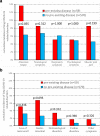Long COVID-19 in children: an Italian cohort study
- PMID: 35659358
- PMCID: PMC9163526
- DOI: 10.1186/s13052-022-01282-x
Long COVID-19 in children: an Italian cohort study
Abstract
Background: Long COVID-19 syndrome is a complex of symptoms that occurs after the acute SARS-CoV-2 infection, in the absence of other possible diagnoses. Studies on Long COVID-19 in pediatric population are scanty and heterogeneous in design, inclusion criteria, outcomes, and follow-up time. The objective of the present study is to assess the prevalence of Long COVID-19 syndrome in a cohort of Italian pediatric primary care patients, observed for a period of time of 8 to 36 weeks from healing. Prevalence was also assessed in a cohort of pediatric patients hospitalized during acute infection.
Methods: Data concerning 629 primary care patients with previous acute SARS-CoV-2 infection were collected by a questionnaire filled in by Primary Care Pediatrician (PCP). The questionnaire was administrated to patients by 18 PCPs based in 8 different Italian regions from June to August 2021. Data concerning 60 hospitalized patients were also collected by consultation of clinical documents.
Results: Cumulative incidence of Long COVID-19 resulted to be 24.3% in primary care patients and 58% in hospitalized patients. The most frequently reported symptoms were abnormal fatigue (7%), neurological (6.8%), and respiratory disorders (6%) for the primary care cohort. Hospitalized patients displayed more frequently psychological symptoms (36.7%), cardiac involvement (23.3%), and respiratory disorders (18.3%). No difference was observed in cumulative incidence in males and females in both cohorts. Previous diseases did not influence the probability to develop Long COVID-19. The prevalence of Long COVID-19 was 46.5% in children who were symptomatic during acute infection and 11.5% in asymptomatic ones. Children aged 0 to 5 years had a greater risk to develop respiratory symptoms, while adolescents (aged 11-16 years) had a greater risk to develop neurological and psychological Long COVID-19 symptoms.
Conclusions: Our study demonstrates that Long COVID-19 is a reality in pediatric age and could involve even patients with mild or no acute symptoms. The results stress the importance of monitoring primary care pediatric patients after acute COVID-19 infection and the relevance of vaccination programs in pediatric population, also in order to avoid the consequences of Long COVID-19 syndrome.
Keywords: COVID-19 in pediatric age; Long COVID-19; Primary care assisted children.
© 2022. The Author(s).
Conflict of interest statement
The authors declare that they have no competing interests.
Figures
Comment in
-
Long COVID-19/post-COVID condition in children: do we all speak the same language?Ital J Pediatr. 2023 Jan 20;49(1):12. doi: 10.1186/s13052-023-01417-8. Ital J Pediatr. 2023. PMID: 36670478 Free PMC article.
References
-
- Onder G, Floridia M, Giuliano M, Lo Noce C, Tiple D, Bertinato L, Mariniello R, Laganà MG, Della Vecchia A, Gianferro R, De Feo A, Cosenza P, Di Corcia T, Gianfranco Gensini G, Palummeri E, Frabetti C, Aliberti S, Campana A, Carfì A, Landi F, Rossi A, Cherubini A, Uccelli A, Barisione E, Benedetti L, Bartoloni A, Bonfanti P, Carlesimo M, Guaraldi G, Milic J, Leonardi S, Petrosillo N, Tarsia P. Indicazioni ad interim sui principi di gestione del Long-COVID. Versione del 1° luglio 2021. Roma: Istituto Superiore di Sanità; 2021. (Rapporto ISS COVID-19n. 15/2021). https://www.iss.it. Accessed 30 Oct 2021.
-
- Huang C, Huang L, Wang Y, Li X, Ren L, Gu X, Kang L, Guo L, Liu M, Zhou X, Luo J, Huang Z, Tu S, Zhao Y, Chen L, Xu D, Li Y, Li C, Peng L, Li Y, Xie W, Cui D, Shang L, Fan G, Xu J, Wang G, Wang Y, Zhong J, Wang C, Wang J, Zhang D, Cao B. 6-month consequences of COVID-19 in patients discharged from hospital: a cohort study. Lancet. 2021;397(10270):220–232. doi: 10.1016/S0140-6736(20)32656-8. - DOI - PMC - PubMed
MeSH terms
LinkOut - more resources
Full Text Sources
Medical
Miscellaneous


